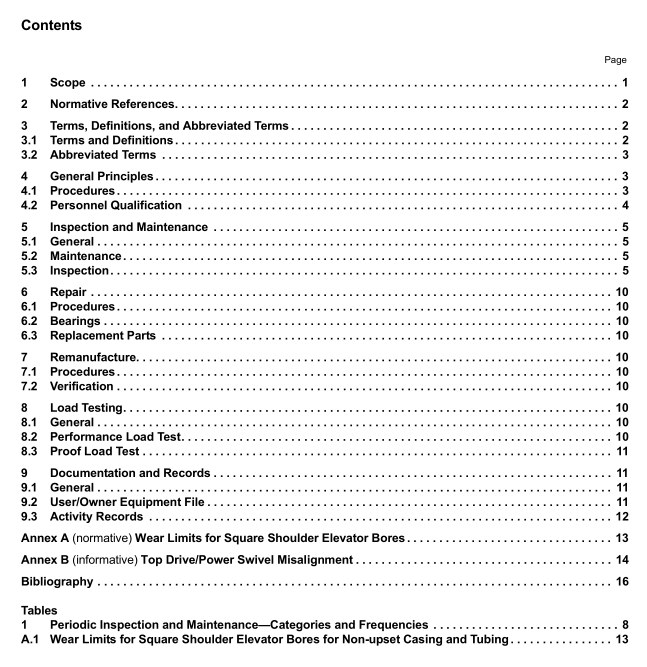API RP 8B pdf download

API RP 8B pdf download Recommended Practice for Procedures for Inspections, Maintenance, Repair, and Remanufacture of Hoisting Equipment
Other NDT techniques applied to hoisting equipment shall be submitted for the specific approval of both userlownerand manufacturer.
5.3.5 Results of lnspections5.3.5.1Acceptance Criteria
Acceptance criteria shall be established based on experience and manufacturer’s recommendations. Womequipment that does not meet the acceptance criteria shall not be accepted for operation.
5.3.5.2 Rejected Equipment
Rejected equipment shall be marked and removed from service.5.3.5.3Surface Indications
Surface indications identified by NDT may be allowable or non-allowable depending on their size,shape, andlocation, as defined by the manufacturer.
5.3.5.4Allowable Surface lndications
Allowable surface indications are surface indications of such a size, shape, and location that they need not beremoved.
5.3.5.5 Non-allowable Surface Indications
Non-allowable surface indications shall be classified as follows.a) Minor surface indications:
Minor surface indications may be removed by fling or grinding if this can be achieved within the limits specified bythe manufacturer, othenwise they shall be classified as major surface indications. Caution should be exercised toprevent heating to an extent that could change the mechanical properties, including toughness, of the material.a) Major surface indications:
Major surface indications, which require material removal beyond the limits specified by the manufacturer, shouldbe corrected by remanufacture.
5.3.6Inspection and Maintenance (Lubrication) of Wire Rope
Inspection and maintenance (lubrication) of wire rope used in hoisting shall be carried out on a regular basis.APl RP9B[1] may be consulted for further information on inspection and maintenance of wire rope.
5.3.7 Wear Limits for Square Shoulder Elevator Bores
Wear limits for square shoulder elevator bores for casing and tubing shall be as specified in Annex A.5.3.8 Inspection and Maintenance for Top Drive/Power Swivel Misalignment with the Wellbore
Inspection and maintenance for top drive/power swivel misalignment with the wellbore should be carried out as notedin Annex B.
6 Repair
6.1Procedures
Manufacturers should provide adequate infomation to allow the equipment userlowner to identify the nature ofrepairs that may be required. Repairs shall be performed using methods or procedures established in accordancewith 4.1.
6.2Bearings
Anti-friction bearings play an important part in the serviceability of equipment. The most likely causes of the need forbearing replacement are very loose or bent cages (rolling element retainers), corrosion, abrasion, inadequate (orimproper) lubrication and spalling due to fatigue.Excessive clearance may indicate improper adjustment or assemblyand should be corrected.Repair of anti-riction bearings should not be attempted by field or shop personnel. Theequipment manufacturer should be consulted in the event of unexplained or repeated bearing failure.
6.3Replacement Parts
All replacement primary-load-carrying components shall meet or exceed the original manufacturer’s criteria and thefollowing requirements:
a) the primary-load-carrying components shall be subject to the same minimum requirements and standards as the
original equipment components;
b) the documentation and traceability requirements shall be the same as for the original equipment components.7Remanufacture
7.1Procedures
Remanufacture of equipment shall be performed using methods and procedures developed in accordance with 4.1.The material used for the remanufacture shall be qualified to the manufacturers requirements for mechanicalproperties, ductility and toughness. The equipment rating resulting from remanufacture should be in accordance withthe equipment manufacturer’s recommendations. Equipment that cannot be remanufactured shall be destroyed.
lf welding is necessary, it shall be performed in accordance with a witten procedure that has been qualified inaccordance with a recognized standard.
7.2 Verification
Following remanufacture,verification shall be performed in accordance with 5.3.4.Load Testing
8.1General
Two types of load test are described, as follows.









